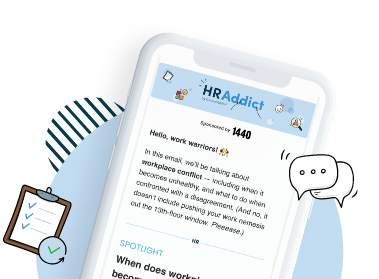The ongoing COVID-19 pandemic has changed and challenged every company across the globe. While numerous industries had to transition to remote work seemingly overnight, others have been in standstill ever since government-imposed lockdown measures were implemented by several nations.
But as more and more countries manage to flatten the curve, businesses are gradually resuming their operations and opening their doors once again. However, with strict safety measures and laws still in place, companies are expected to meet certain requirements as their workforce starts going back to work.
Our article and infographic outline some key considerations for returning to work after COVID-19 for employers and HR managers, as well as the most important steps to take before your employees return to the workplace.

1. Consult with Your Team
Before your team can return to the workplace, you must maintain an open dialogue about what the return would entail – transparency, after all, will help your team adapt to the new changes successfully.
Start preparing your staff by telling them what they should expect by sharing new guidelines, policies and company measures that will be taken to ensure their safety.
Receiving feedback from employees could also allow you to identify and reassess certain risks and find effective solutions for them. You may also have to liaise with worker unions and department representatives before taking any further steps.
Through your conversation with your employees, you might find that some people might not feel safe returning to work just yet. As an employer, you must listen to their concerns and, if feasible, to provide alternative solutions such as remote work. It might be sensible to ask your team to continue working from home instead of coming into the office, as this could hinder their productivity.
2. Phase in the Return
Many companies are choosing to phase in the return of their staff. This way, you can reduce overcrowding at the office by having different groups come in on shifts on different days.
Create your groups based on their duties and prioritise those whose presence is essential for procedures to resume. Meanwhile, allow remote work to continue for those who can carry on with their responsibilities without needing to be physically present.
Phasing in the return to the office will help everyone grab their bearings and gradually adapt to these changes. It gives everyone time to get used to the new policies, office layout and rhythm without having to navigate congestion as well.
When deciding who will return to work, you should also take into consideration the employees who belong in vulnerable groups, as you might be required to take additional steps to keep them safe. At-risk groups include:
- Immunocompromised persons
- Pregnant women
- Individuals with chronic conditions such as heart or lung disease, asthma and diabetes
- People aged 70 and over
According to the US Equal Employment and Opportunity Commission (EEOC), an employer should provide reasonable accommodation to vulnerable employees who can only perform their duties at the workplace. These include providing them with additional or enhanced protective equipment, as well as temporarily modifying work schedules to reduce contact with coworkers.
3. Adhere to Government Laws and Policies
It’s essential to keep track of new regulations, laws and policies posed by governing bodies and to ensure that your workplace meets all safety standards before resuming business operations.
These measures could include restrictions on the number of people who can enter your premises per square metre, compulsory safety measures such as wearing face masks in interior spaces, and the temporary ban of indoor seating for bars, restaurants and coffee shops.
Beyond safety restrictions, you must also ensure that company policies concerning your employees are in line with relevant laws. In the US, for example, there are several regulations that employers should adhere to in order to avoid discriminatory behaviour and breach of personal data and employment laws, including:
- The Emergency Family and Medical Leave Expansion Act
- Health Insurance Portability and Accountability Act
- Americans with Disabilities Act
Likewise, in the UK, an employee is protected by law against unfair treatment and dismissal under the Equality Act.
So, before making any decisions that could affect your team, ensure that you consult medical advisors and governmental bodies first.
4. Implement Protective and Preventative Measures
One of the most critical steps you need to take as an employer is to ensure that there are sufficient safety measures in place to keep your employees healthy and safe. Before their return, outline the actions that will be taken and share this information with your staff.
There’s a lot of ground to cover, but in a snapshot, these are some actions you should take:
- Offer your team the necessary personal protective gear, including face masks and gloves.
- Introduce systematic cleaning of the premises, especially communal areas such as lunchrooms, restrooms and locker rooms, but also of equipment, tools and desks.
- Arrange for weekly disinfection services to reduce chances of infection.
- Ensure that there is proper air ventilation by using mechanical or natural ventilation and avoid using units that recirculate the air in a room.
- Limit the number of external visitors entering the premises.
- Discourage formalities such as handshakes.
- Implement social distancing measures.
- Mandate the use of face masks in areas of significant community transmission.
5. Prepare the Workplace
Once you’ve outlined your company’s safety measures, it’s time to put them in place. Start by adapting your workspace so it can accommodate these changes.
To begin with, you will need to modify the layout of the office to ensure that social distancing is possible. This could mean moving desks further apart, removing seating in the canteen or the breakroom and repurposing meeting rooms into workspaces so there’s less congestion.
It might also be wise to cord off rooms where social distancing isn’t possible and limit the number of people that can be present in each room, depending on its square footage. It’s also crucial that you provide hand sanitiser at every entrance and exit, as well as in communal areas and at individual desks.
On another note, eliminate communal desks, equipment, tools and office supplies such as printers, pens and cutlery. Plus, remove items such as magazines, product catalogues and stationery from waiting rooms, reception areas and salesrooms.
Depending on your type of business, you should also consider installing protective screens at checkout counters and adding floor markings to indicate the recommended two-metre distance between people standing in line.
6. Promote Personal Hygiene Etiquette
Keeping proper hygiene is always important, but in the context of the pandemic, it is crucial.
Your employees and customers should be pretty familiar with the necessary hygiene habits that have been continuously reiterated ever since the start of the outbreak. However, just in case these habits have yet to be imprinted on some people’s minds, you should still make an effort to instil these habits in all your stakeholders. Here’s how:
- Remind workers to follow the CDC’s protective guidelines which include washing their hands frequently and for at least 20 seconds, especially after using the bathroom; after blowing their nose, coughing and sneezing; and before eating.
- Put up posters with visual instructions on how to properly wash your hands.
- Put hand sanitiser outside every bathroom and communal area and instruct employees to use it upon their entering and exiting of these areas.
- Advise employees to always use tissues when sneezing or coughing and dispose of them properly after.
7. Revise Your Company Policies
With these new circumstances, you might also need to change your company policies for the benefit of your team. In the US, for example, major retail and grocery stores such as Target and Costco have made the use of facemasks a compulsory service policy. While this action received some backlash, it effectively creates a safer space for both your employees and customers.
However, James Biscone, a personal injury and workers’ compensation lawyer, told Business Insider that businesses need to ensure that such policies do not discriminate against people with disabilities who may be physically unable to wear a face mask.
You could also adapt your services so you can safely cater to your clientele. For example, consider the benefits of online commerce, click-and-collect schemes and home delivery. This will allow you to minimise contact with others and keep your employees safe while resuming your operations.
Likewise, companies that require face-to-face meetings with clients can adapt their services by offering online consultations and hosting meetings in virtual boardrooms.
8. Take Mental Health into Account
Of course, you can prepare the physical space of a business to meet all safety standards and reduce infection risks. However, you must also invest in your employee’s mental wellbeing. This is something that is often overlooked by most businesses but it’s equally important to other health measures.
Even if social distancing policies are strictly followed and personal hygiene is observed, your employees’ mental state will also need to be addressed. Flexible management will allow you and your team to navigate the new workplace landscape. Allowing them to work as they see fit (a few days from home and a few at the office, for example) could ease up on the pressure everyone is experiencing at the moment and make the office seem a lot less like a virus minefield.
According to a study by the National Alliance of Healthcare Purchaser Coalitions (PDF), 53% of 256 employers provided special emotional and mental health programmes to their staff due to the pandemic. Indeed, the pandemic has highlighted the need for companies to start providing such resources to their teams. From meditation to sleep and emotional resiliency, these initiatives could promote different areas of mental health, writes Kathryn Mayer, the benefits editor of Human Resource Executive.
9. Review Your HR Policies
Under the given circumstances, reviewing your HR policies might be a wise idea – especially for matters concerning remote work, taking time off and sick leave.
With an ongoing pandemic, remote work has allowed numerous companies to stay afloat during this crisis while keeping their employees safe. If remote work is a viable option for your business, consider allowing people to work from home indefinitely, with more priority to vulnerable groups and parents without access to childcare services.
Of course, for this to be a tangible option, you should solidify certain aspects of remote work by outlining specific policies, such as the use of online tools, security software, working hours and monitoring.
Meanwhile, the CDC advises employers to introduce leave policies that ‘actively encourage sick employees to stay home’. Even if your company is not legally obliged to provide paid leave, consider how a leave coverage could benefit the health and wellbeing of not just the sick employee but your entire workforce.
Returning to work might prove to be a lot more challenging for some than others. Companies must not only implement safety measures that will protect their employees and clientele but, in some cases, also reconsider and reformulate their approach to company culture, employee mental wellbeing and general HR policies.
Arguably, the return to the workplace could signal fundamental changes to business models that cannot withstand the changes brought about by COVID-19. By carefully following the steps presented in this guide, you can ensure that your company makes a grand comeback post-COVID-19 lockdown!
How has your company coped with the return to work after lockdown? Let us know in the comments section below!

